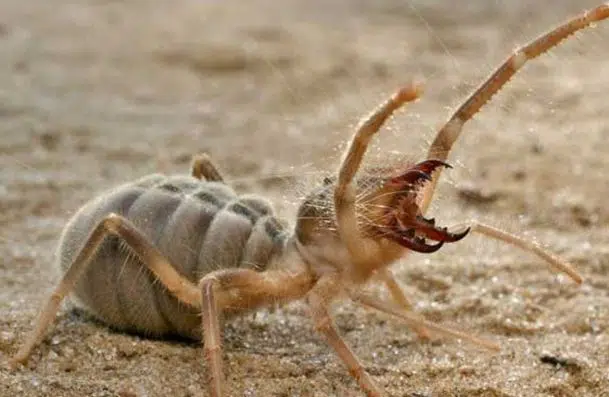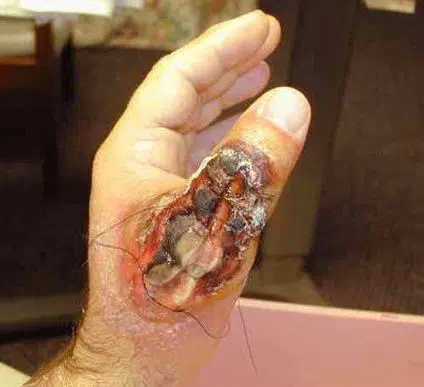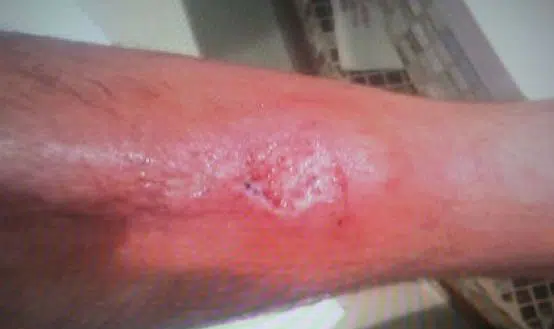What does a camel spider bite look like? What are the symptoms? Is it dangerous? Here’s a detailed guide on the effects of camel spider bites, its signs, how to identify it and treatments.
The camel spider also known as wind scorpion, or the sun spider came to be an internet sensation in 2003, during the Iraqi war. It is during this period that rumors of their cruel nature started circulating online.
Some of the tales in circulation were being accompanied with camel spider bite pictures, which purported to show spiders that were half the size of a human being and the kind of harm (side effects) that they could cause if they were to bite you.
Through the years, the rumors from the Middle East have painted the sun spider as a large, and highly venomous creature, which is capable of running as fast as a man, and one that has an insatiable appetite for large living things. But, the truth is, all these are myths, which are not true
What is a camel spider?
The history of the camel spiders starts with misidentification. Camel spiders are not real spiders, but they are class Arachnida members. It is the same class that contains the spiders, scorpions, and mites.
A camel spider (sun spider, sun scorpion) is not venomous, but is capable of inflicting an extremely painful bite.
A camel spider can best be described as a solifugae. It is a term derived from Latin, that means those who bolt from the sun. Normally, the spider is not aggressive towards man, and it only bites when it feels that it is under threat.
- When looking at a camel spider bite photo, you will realize that the creature is not big, and that its length often depends on its species.
- In terms of color, the spider can either be light gray, brown, or beige.
- Without counting its legs, a wind scorpion can range between 0.4 and 6 inches, making it a very small
Its abdomen is segmented, and round in nature and has very long hair, which is intended to cover its legs from the direct sunlight. One of the most notable features of this spider is that it has massive paired jaws that act as a grouping of pliers/knife tools and which have maximum effects on their victims whenever they bite.
See also:
- What does a wolf spider bite look like? (PICTURES)
- Flea bites vs. bed bug bites: What is the difference?
- How do flea bites look like on humans?
Where do wind scorpions live?
Wind scorpions are typically found in arid, warm areas of the deserts globally, except Australia. The camel spider does not like to be exposed to the sun rays, and as such, they tend to retreat to logs, under huge rocks, and other debris.
Also, they can burrow into soil or sand in an attempt to escape the daytime heat. It is most active at night. Be careful of such sites as you will put yourself at risk of a camel spider bite.
Camel spider bite pictures and photos
What does a camel spider bite look like? From the camel spider bite photos here, you can note that the initial bite is about a third of their overall size, thanks to their large jaws.
The camel spider uses the jaws to seize its victim, and then turn it to a pulp using a sawing or chopping motion. Even though they are not dangerous to a human being, they have digestive enzymes that they use to liquefy the victim’s flesh.
Hence the pus like appearance on the camel spider bite pictures as the open wound often gets infected quite fast. When liquefied, it becomes easier for them to suck these remains. Here are photos to help you identify camel spider bites.
Camel spider bite effects
What happens if a camel spider bites you? With camel spiders, there is nothing much to fear in terms of the camel spider bite effects as it does not have any venom in its jaws. Additionally, it does not have the capacity to create its own web like the other spiders.
Just as is the case with many non-poisonous spiders, a camel spider will only bite a human being because it feels threatened, and not because it is its nature to bite.
However, when it does bite you, it can injure you with its strong jaws, which are capable of breaking your skin open.
This is where they become dangerous to a human being. Once open, one of the camel spider bite effects is the fact that it can lead to the wound becoming infected. In rare cases, this wound could lead to sepsis. Wound infections come about because the jaws are often covered with rotting residues from their previous preys, which then gets into your wound during the bite leading to the infection.
Symptoms of a camel spider bite
You can use the following signs and symptoms to differentiate between a normal spider bite and a camel spider bite. They include:
- Experiencing intense pain—it is one of the most common camel spider bite symptoms. This is attributed to the presence of its plier-like jaws, which are responsible for chopping its victims.
- Swelling in the affected area—swelling is another symptom that you can expect. Once bitten, the bite will cause a lot of trauma in the surrounding skin tissues. The swelling is the body’s response to the bite but is another important sign that you need to be on the lookout for.
- Bleeding—the moment you have been bitten, you will immediately notice blood in the affected region. Bleeding can be mild or intense, as it will depend on the size of the camel spider that bit you.
- Infection and sepsis—given that the bite leaves behind an open wound and some bacteria have been left behind, the wound is likely to become infected, and if not treated in time, it could lead to sepsis.
- Allergic reaction—in some cases, its symptoms are worse than expected due to allergic reactions. Itching, swelling, and redness could become more intense.
Treatment and first aid for camel spider bites
Given that there is a risk of getting infected, it is important to ensure that this wound gets treated as soon as possible. You should note that in some cases, first aid treatment for a wound is sufficient. Therefore, you may not need to seek emergency care. But, you have to ensure that you monitor the symptoms very closely and in case they become severe, you should seek proper medical care. Camel spider bite treatment includes:
- Use a saline solution or mild water and soap to wash the bite, as well as the affected region. Even though the spider does not have any venom, the wound may contain some bacteria, which may later lead to unwanted spider bite effects. You should, therefore, ensure that it is well cleaned.
- Once it is clean, carefully dry it off using a soft, clean towel
- Use a cotton wool to apply an antiseptic solution to this wound
- Locate an antibiotic cream and proceed to apply it to the open wound. The cream is active against protozoa and anaerobic bacteria. You should leave the wound open for at least fifteen minutes.
- Camel spider bite treatment may also involve the use of a hydrocortisone 1% ointment or cream, which is ideal for reducing inflammation
- Depending on the size of the bite, you could apply a gauze bandage or Band-Aid.
- The bandage will need to be changed each day. As you do so, be sure to check whether there are any infection signs.
- A cold compress will come in handy in helping you numb the area that was bitten, in addition to reducing inflammation
Is there need to get a tetanus shot after a camel spider bite? Even though it is not necessary, you can consider getting one, more so if some years have passed by since you got your last shot. Therefore, to be sure that everything is under control, ensure you receive a tetanus shot soon.
Preventing camel spider bites
To ensure that you will not get bitten by the camel spider, you should try the following tips:
- Protect your food and ensure that you do not leave it open—when left out in the open, the spiders will most likely prey on it. You should therefore utilize traditional food storage methods as well as the use of protective containers.
- Stay away from camel spider’s food—one of the primary reasons why people get bitten by this spider is because they live in the same areas as their food. You need to ensure that your place does not have any bugs or insects. The furniture should also be termite free.
Once bitten, the number of days that the symptoms will be with you will depend on a variety of factors e.g. location of the bite, the size of the spider, and your health status. However, the bite should be completely healed within a few weeks, unless some complications arise. In very extreme cases, your physician may be forced to scrape the area where the bite happened. If this was to happen, you might be provided with some prescription antibiotics.
https://www.youtube.com/watch?v=GF_OAzfZEFI
Article Resources
- HX Benefit Editorial Team. (2017, April 24). Camel Spider Bite: https://www.hxbenefit.com/camel-spider-bite.html
- Mijan Krobic. (2017, June 20). Camel spider bite: Images, symptoms, treatments, and facts: http://www.drugsdetails.com/camel-spider-bite-images-symptoms-treatments-and-facts/
- Team health whoop. (2016, Sept 7). Camel spider bite: https://www.healthwhoop.com/camel-spider-bite/
- (2016, August 20). Five facts about camel spiders and their bites: https://getridpests.com/spiders/5-true-facts-camel-spiders-bites.html
- (N.D). Camel Spider: http://www.nationalgeographic.com/animals/invertebrates/c/camel-spider/




